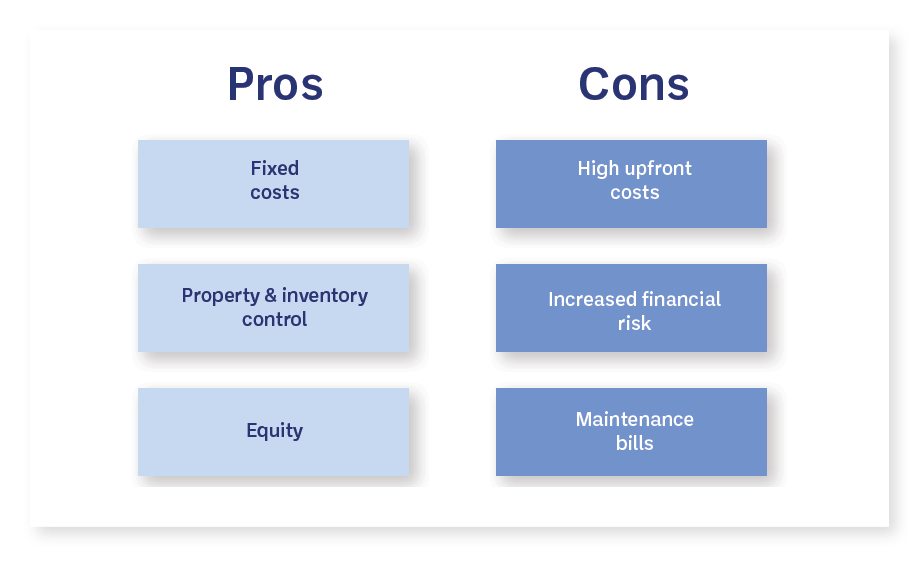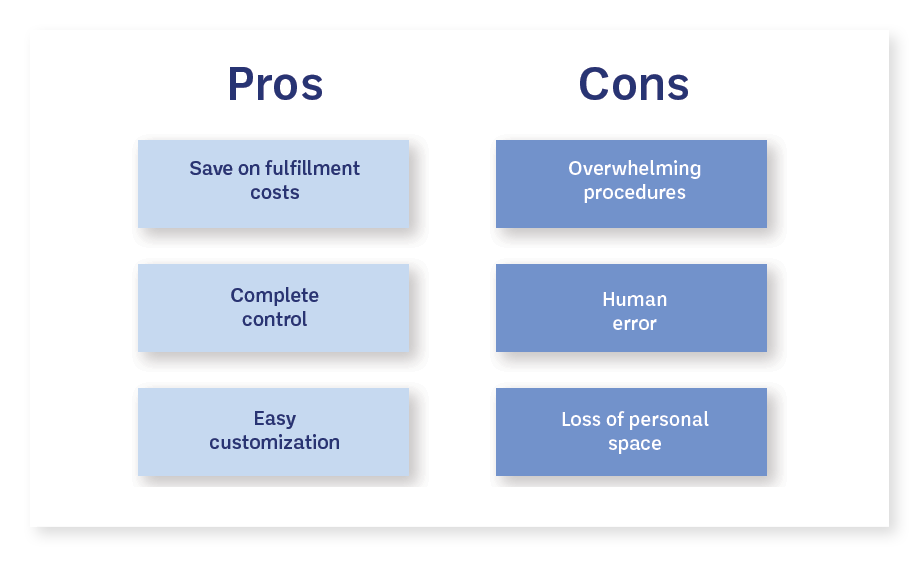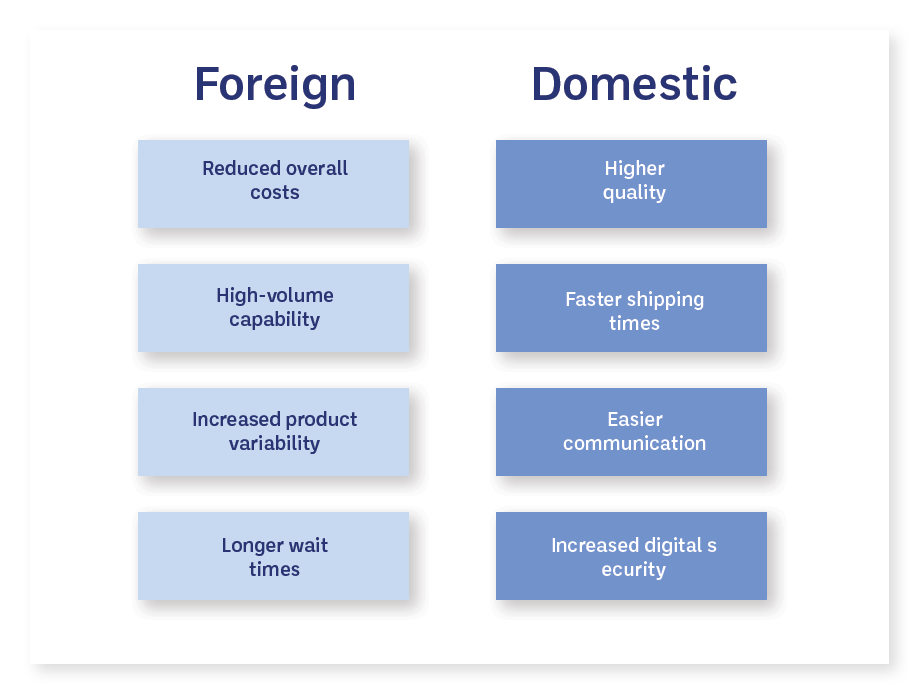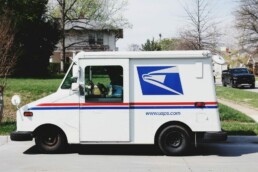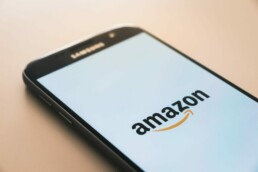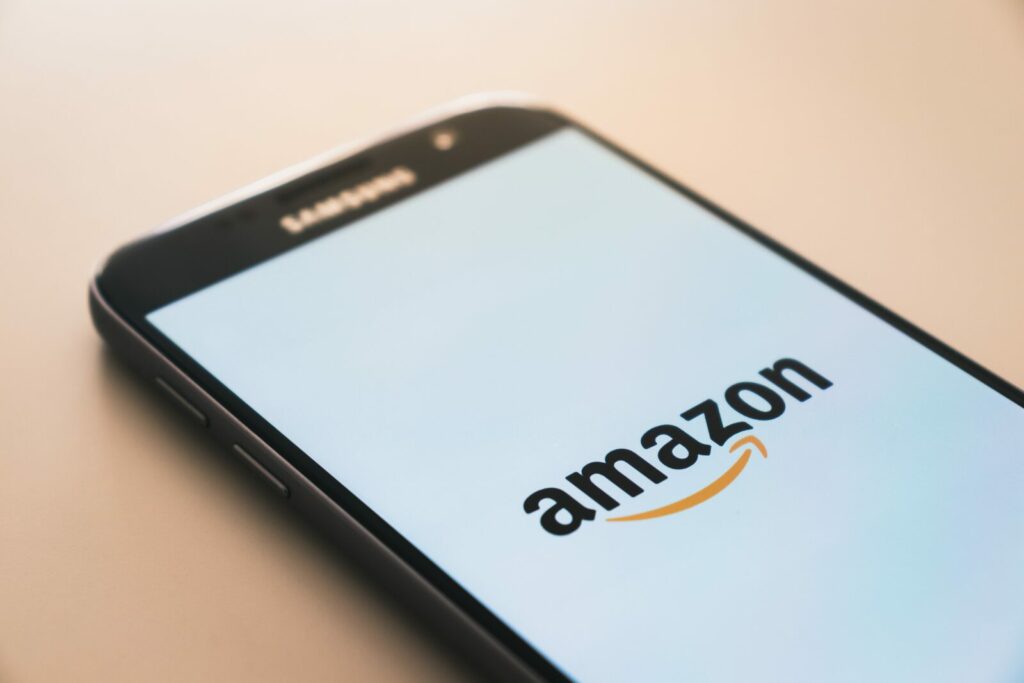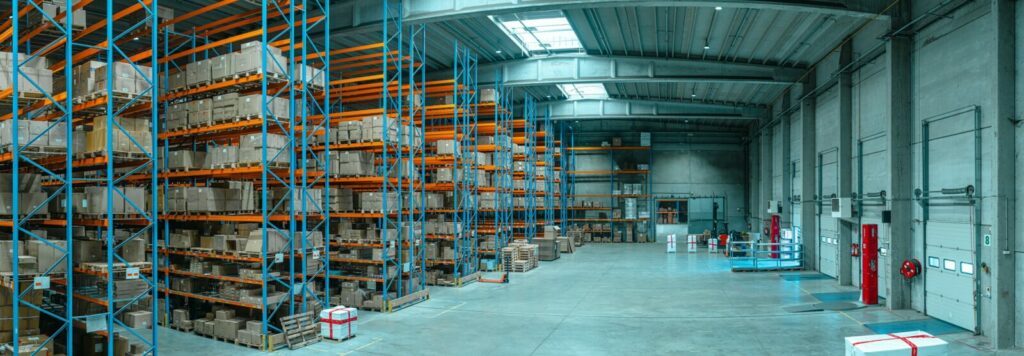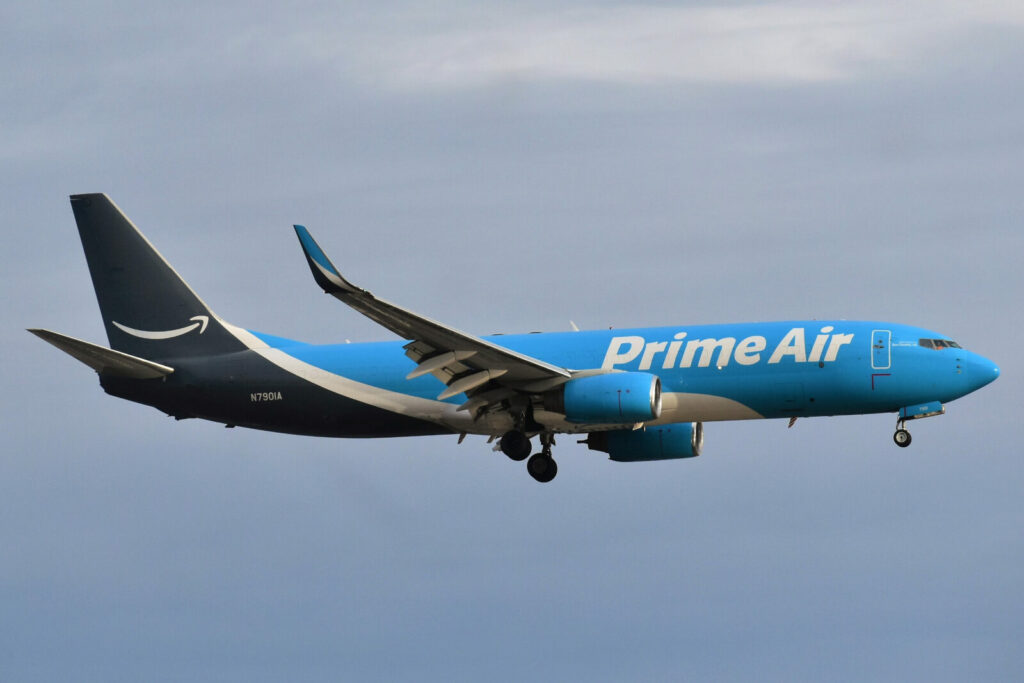Combating the Environmental Impacts of eCommerce: Part 2
Read Part 1: The Environmental Impacts of eCommerce

In part 2 of The Environmental Impacts of eCommerce, we'll be touching on two final impacts of eCommerce and in what ways you can specifically start reducing your carbon footprint and making a positive impact for your shoppers and the earth you share.

eCommerce Returns Account for 5 Billion Pounds of Landfill Waste Every Year
In 2020, the eCommerce sector saw over $428 billion in returns, with an average return rate of 30% for online purchases and between 8% and 10% for brick-and-mortar stores. With a quarter of all consumers returning between 5% and 15% of all online purchases, this results in over 5 billion pounds of returned products and 15 million metric tons of carbon emissions produced every year.
Learn more about the environmental impact of eCommerce returns.

Reduce Your Contribution to the Carbon Emissions Caused by eCommerce Returns
Making your return policy prominent and easy to read for customers is key when reducing overall returns. Help your buyers locate, read, and understand your return policy before making a purchase and blindly returning items. Include important information like return shipping and restocking fees (if any) and define the acceptable conditions of returns. Be clear about what is and isn’t returnable.
Additionally, prioritizing exchanges over returns will help your eCommerce lower its return rate AND its carbon footprint. Making exchanges the preferred option helps direct customers to an eco-friendly choice while still giving them the freedom to decide.
Learn more tips and tricks about avoiding returns altogether.

Growing eCommerce Sales Contribute to 20 - 50 Million Metric Tons of E-waste Every Year.
As the world of technology grows in popularity, so does the global eCommerce sales of electronics. Every year, 20-50 million metric tons of e-waste is produced by mass disposing of items like
- Cellphones
- Laptops
- Keyboards
- Televisions
Which have created the fastest growing waste stream in America. E-waste is not limited to consumers, with companies contributing industrial e-waste like
- Vehicle batteries
- Refrigeration systems
- Automated equipment
- IT equipment
One of the biggest environmental impacts of e-waste is the toxic chemicals it releases. When exposed to heat, e-waste emits chemical substances that damage the atmosphere, toxify groundwater, and dead-zone nearby ecosystems. In a study conducted by the United Nations Environmental Programme, out of 300 school children living near Dandora, the biggest dumpsite in east Africa, half the children tested positive for respiratory problems and 30% had blood abnormalities. Both are indicators of heavy-metal poisoning caused by the toxicity of discarded electronics.

Reduce the Amount of E-waste Being Sent to Landfills
As an eCommerce company, it’s important to take a holistic approach to minimize your impact on the planet. By partnering with electronic recycling programs or joining the Sustainable Materials Management (SMM) Electronics Challenge, you’re able to responsibly recycle electronics from in-house tech equipment to industrial batteries.
Additionally, by repairing devices once they’re damaged or outdated instead of replacing them, you can reduce additional waste and save money. Those laptops you plan on throwing away for lagging problems could need a simple hardware update and they’ll be ready to tackle the next round of staff.
Care with Falcon
In today’s world, eCommerce companies could drive themselves mad trying to tackle every good cause. . That’s why, when you partner with Falcon, you contribute to sustainability practices that would otherwise be overwhelming. Here at Falcon, we are experts in sustainable fulfillment. Reduce your carbon footprint, appeal to growing eco-trends, and show the world how much you love the planet by delivering a green experience time and time again.
The Environmental Impact of eCommerce: Part 1
Read Part 2: Combatting the Environmental Impact of eCommerce
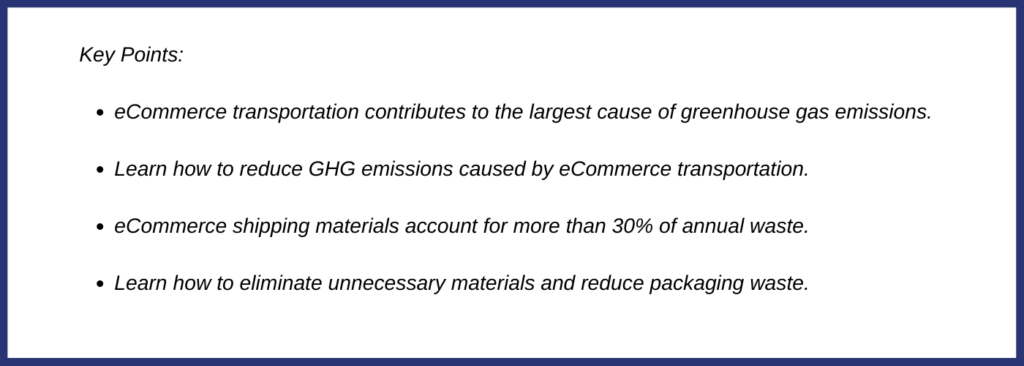
As eCommerce becomes the new normal for what was once primarily traditional brick-and-mortar experiences, rising eCommerce concerns are capturing the attention of shoppers and businesses alike. Although there are many concerns, we will focus on four environmental impacts of eCommerce that have emerged in recent years and what steps you can take to reduce these impacts.

eCommerce Pays Significant Contribution to the Largest Cause of GHG Emissions
Together, FedEx and UPS deliver over 34 million packages every single day. Combine that with thousands of private truckers, shipping carriers, planes, ships, and freights. This makes up a considerable amount of the 29% of GHG emissions attributed to the transportation sector.
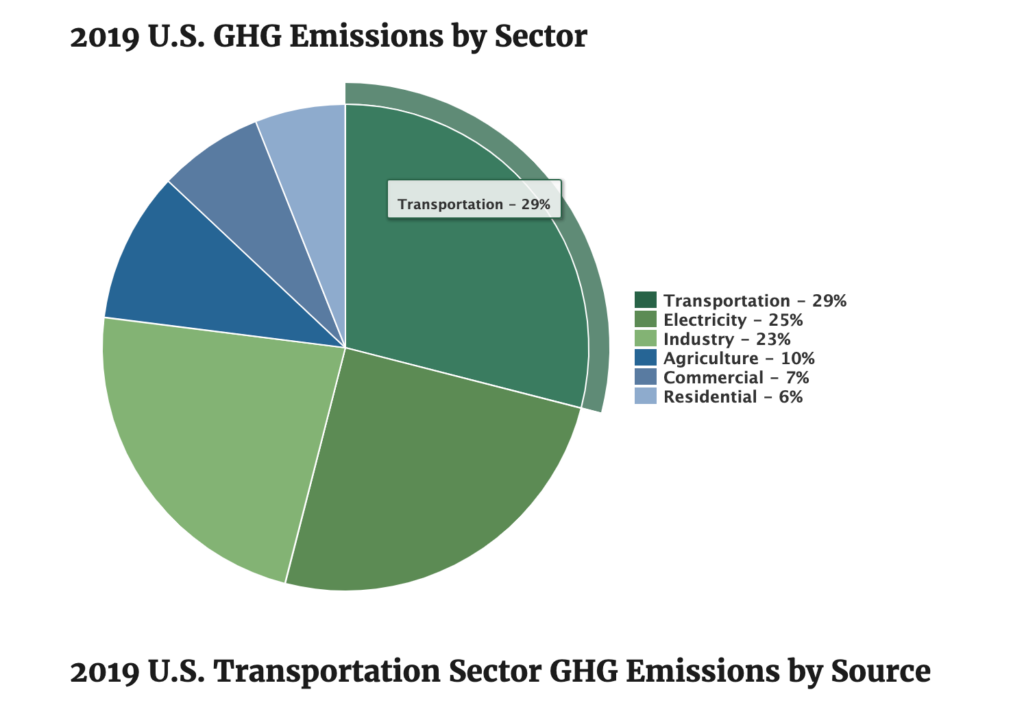 Image credit to EPA
Image credit to EPA
For each gallon of fuel used by a common delivery van, about 22 pounds (10 kilograms) of CO2 is released into the atmosphere. A delivery carrier traveling over 5,100 miles a year to fulfill next-day orders amounts to an annual 8 metric tons of CO2 for an average delivery van.
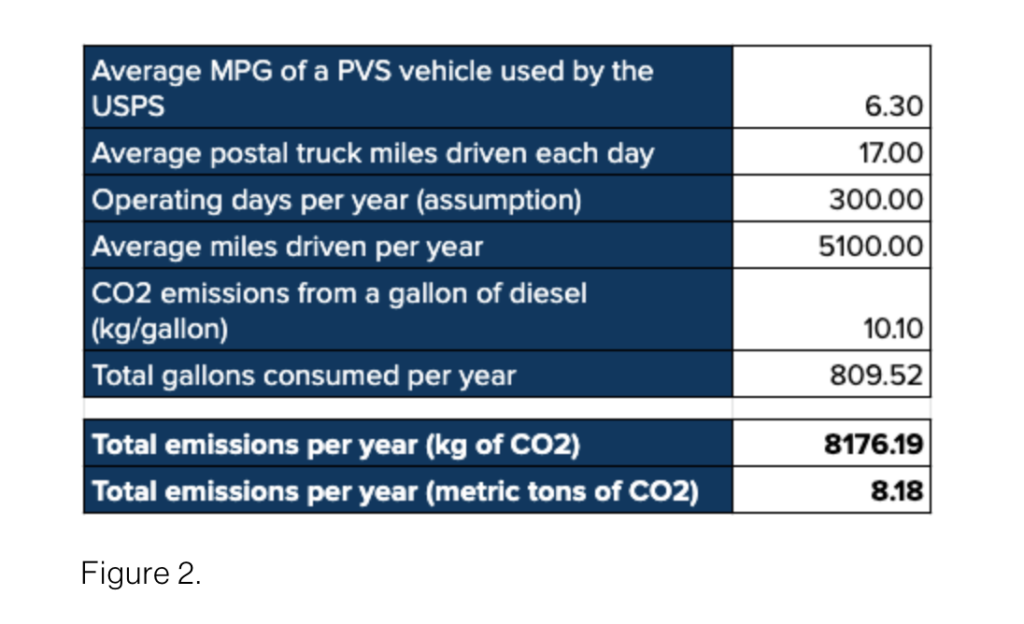 Photo credit to GlobalCurrent.com
Photo credit to GlobalCurrent.com
The impact of eCommerce transportation will continue to expand. With consumer demand steadily increasing, eCommerce is expected to reach over $6 trillion in sales by 2024. This means we will likely see increased energy consumption, expanded infrastructure, and additional traffic due to delivery providers and fulfillment agencies.

Combat Greenhouse Gas Emissions by Utilizing Alternative Delivery Options
BOPIS
Buy online pick-up in-store remains a popular option amongst online shoppers. By offering customers the ability to pick up their items at a physical storefront, eCommerce companies help eliminate vehicle emissions for individual orders. The reduction of orders helps minimize the contribution to transportation pollution.
Use Multiple Fulfillment Center Locations
Whether you’re investing or you choose to partner with a 3PL provider, utilizing multiple fulfillment locations helps your eCommerce reach customers faster, regardless of their location. When your eCommerce has multiple distribution centers, the time it takes for orders to reach customers is reduced and pick-up options become more convenient for shoppers.
Pick-up Points
Pick-up points range from storefront locations and public parcel lockers to picking up from participating partners like the local grocery store. These options allow customers to choose locations based on their needs, schedule and reduce the need for commercial product delivery.
Sustainable Carrier Programs
Popular shipping carriers like UPS and FedEx are now offering low-emission delivery vehicles, bicycle deliveries, and other efforts toward carbon offsetting and reducing GHG emissions. By partnering with carriers who have a focus on sustainability, you gain eco-friendly credibility for your eCommerce company not just in the eyes of shoppers but for the planet too.
Purchase Carbon Offsets
Carbon offsets are great options for reducing vehicle GHG emissions - or any kind of pollution for that matter. By determining how much CO2 your company emits a year, you can become carbon neutral by purchasing carbon offsets. These programs reduce your carbon footprint without making drastic changes to your company's operations or structure.

The eCommerce Industry is Creating a Massive Cardboard Footprint
During a 2018 EPA study, out of 82,000 tons of containers, packaging, and shipping materials, only half were recycled, resulting in over 30,000 tons of landfill waste. This accounts for over 30% of the total annual waste in the US.
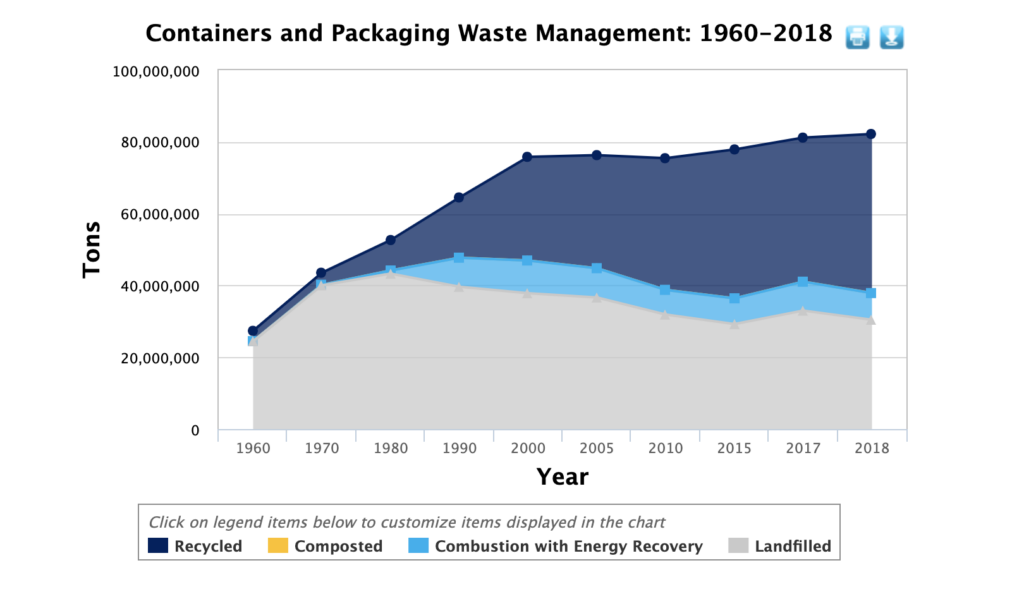 Image credit to EPA
Image credit to EPA
Learn what happens to returned items and other eCommerce waste when they’re sent to a landfill.
A noticeable amount of eCommerce packaging waste comes from:
- A lack of space efficiency
- Poor vehicle consolidation
- Impulse shopping habits from consumers
- Exessive packaging
- Non-recyclable material
By using right-size boxes, bundling orders, and filling up all available space in delivery carriers, your eCommerce can reduce transportation emissions by decreasing travel time and the number of trips it takes to fulfill orders.

Improve Packaging Procedures and Switch to Sustainable Materials
Reduce Unnecessary Packaging
Right-size packaging is important when reducing your package and material waste. By utilizing the right-size shipping containers according to individual product sizes, you eliminate unnecessary room and the need for extra packaging filler. With less room to move around, items are tightly secured and have a lower chance of being damaged, while safely making it to your customers without the extra wasteful material.
Make Packaging Recyclable, Reusable, or Biodegradable
Investing in recyclable materials helps your eCommerce make a greener impact even after orders have left your hands. Providing customers with less packaging and recyclable material, shoppers are able to contribute to a positive environmental impact by following the recycling directions.
For companies looking to deliver a more creative approach, integrating reusable purposes into product packaging reduces waste while also providing your customers with additional ways to enjoy your brand. Consider reusable packaging ideas like:
- Packaging that can be re-purposed into product holders.
- Shipping boxes that can be re-purposed into a cardboard castle for cats.
- Packaging that can be re-purposed as hangers or for product organization.
Another great option is to make your eCommerce and shipping packaging biodegradable. This way, whatever material does make it to your customer, you won’t have to rely on them to recycle or reuse. Shoppers can dispose of packaging and waste will take less than 180 days to fully decompose when appropriately sent to an industrial facility.
Conclusion
From GHG emissions to a massive cardboard footprint, the environmental impacts of eCommerce are real and important for consumers and businesses alike to consider. Knowing that eCommerce transportation contributes to the highest cause of GHG emissions and is responsible for 5 billion pounds of annual landfill waste presses the point to shift to sustainable practices. Fortunately, we can reduce the global environmental impacts of eCommerce by utilizing alternative delivery options such as delivery pickup points and 3PL partners, as well as combat landfill waste by switching to smaller boxes and sustainable packaging materials.
Take Sustainability Seriously
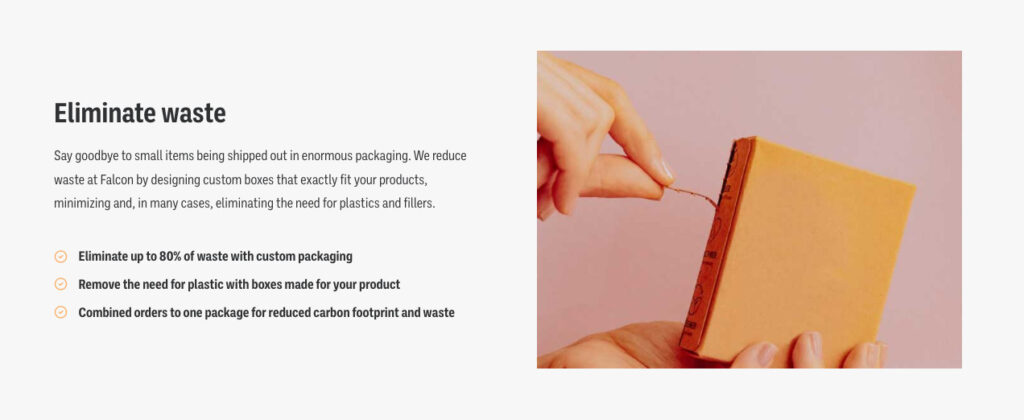
Take a step toward sustainability and talk with one of our agents today. Not only can we deliver the one-of-a-kind experience you’ve created for your loyal customers, but we can deliver it with minimal negative environmental impacts.
Make sure your customers know the planet is important to you and partner with Falcon today.
2022 eCommerce Personalization Trends
As the world of eCommerce continues to grow as the number one way to shop, the need for a personalized customer experience grows. Here are a few eCommerce personalization trends and tools you can utilize right now to personalize the shopping experiences of your customers.
2022 eCommerce Personalization Trends
Intelligent Product Page Recommendations
Leverage dynamic upselling by utilizing intelligent product recommendations for customers. PDP recommendations show shoppers similar or complementary products based on the items they’re currently browsing and allow you to successfully cross-sell and up-sell items without overwhelming shoppers.
Using product detail pages makes it easier to recommend other items to shoppers and inspires an increase in order size before check-out.
Here are a few of the top eCommerce recommendation system products on the market.
Resumed Shopping for Returning Customers
When Netflix introduced the “resume watching” feature, brands ran with the idea for the purpose of eCommerce personalization. Now, shoppers returning to your store can automatically resume right where they left off with previously chosen products still in their cart, ready to purchase.
This improves efficiency and increases customer checkout rates by reminding shoppers of the products they previously loved. This helps eliminate decision fatigue and puts them closer to the finish line instead of starting over.
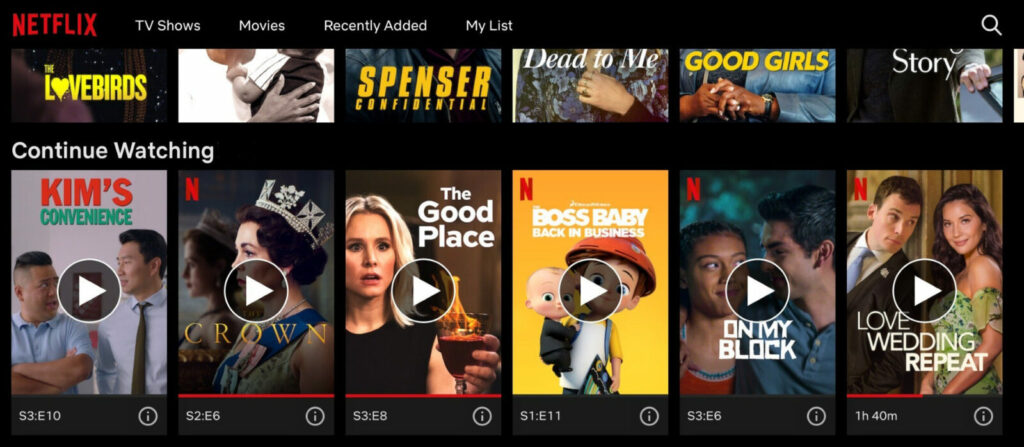
Trending Searches
Is there a specific product or keyword buyers use often when navigating your eCommerce store? Add it to the prepopulated dropdown menu in your search bar. This will not only show shoppers trending searches, keywords, and products but will also direct them toward popular items and things they wouldn’t otherwise have thought to explore.
Some good ideas for pre-populated dropdowns could be:
- Most searched products
- Most bought products
- Most reviewed products
- Highest-rated products
Personalized Bestsellers
It’s common sales and marketing knowledge that the majority of consumers will buy something because other shoppers have recommended or liked it. By incorporating a personalized bestseller list, you can advertise based on various aspects that target customers directly.
Create a bestseller strategy using these ideas:
- Highest reviewed products
- Most popular products within the last week, day, hour, etc.
- Products according to location or weather
This strategy can be particularly useful when you have a diverse customer base. What performs well in LA, may not perform as well overseas. By targeting locations, climate, or even specific consumer groups, you can personalize shopping experiences based on individual and fluctuating factors.
Integrate User-Generated Content
54.7% of consumers read at least 4 reviews before making a purchase. This shows that peer-based decision-making is an important decision driver for shoppers. By integrating user-generated content into your eCommerce store, visitors get the chance to see your product in real life and read honest reviews from real people.
SeaVees has a great strategy utilizing UGC by linking each product directly to a curated collection of posts submitted by customers through the SeaVees hashtag.
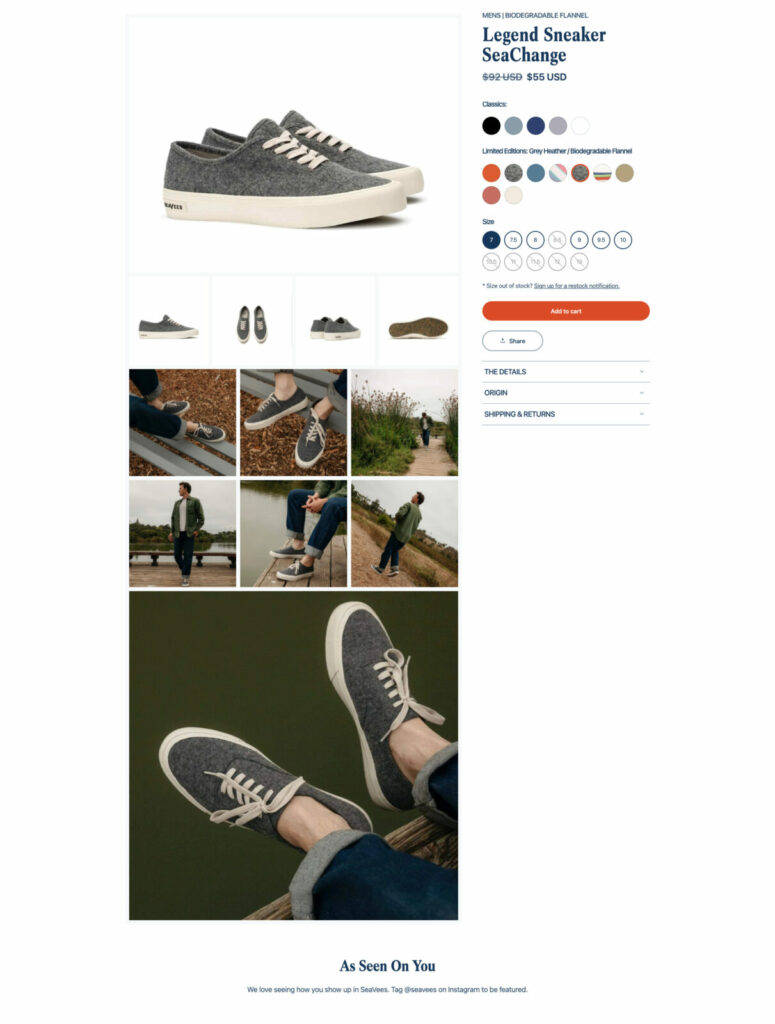
Target Shoppers Based on Behavioral Triggers
Targeting customers that are new or returning to your website is essential when establishing appeal and retaining the interest of shoppers. Consider using timed or triggered popups to offer discounts that match your visitor’s in-session behavior. Some great examples are:
- Offer first-time visitors exclusive discount codes in exchange for an email address
- Trigger promotional pop-ups that entice visitors to reach a higher price threshold in exchange for free shipping, discounts, etc.
- Re-engage returning visitors with reminders of what they previously browsed (and never purchased) to drive them towards checkout.
Automated Personalized Emails
Once you’ve gained the email address of your customer, you have another method to engage with them. By utilizing personalized emails triggered by customer behavior, you’re able to retarget customers who might have otherwise slipped through your fingers.
Abandoned Cart Messaging
Send an email to the customers who spent half the afternoon window shopping, only to abandon their cart and return to normal life. Send them a cart abandonment email notification reminding them that their windowshopping fantasies can become a dream come true in a few simple clicks.
“We Miss You” Messaging
Maybe a customer visited your store, spent a good amount of time on every page, and even provided their email but they ultimately disappeared. Let them know they’re missed. Take it one step further and offer a welcome back discount to entice shoppers to return after their extended time away from your store.
Show Personalized Store and Delivery Information
By using geo-targeting, you can provide shoppers with a personalized delivery estimate or the closest storefront location. When providing more information for customers with little to no effort on their part, shoppers are more enticed to purchase an item knowing it’s 10 minutes down the road or 2 days away from being delivered.
Utilizing 2022 eCommerce personalization trends like targeted pop-ups, trending searches, automated messages, PDP’s, UGC, and customized geo-tagged information, will help you provide a personalized experience to shoppers that allows them to connect with your brand in a way they never have before.
Personalize with Falcon
Falcon specializes in fulfillment. We provide a personalized experience through accurate delivery times, tracking, and updates. Furthermore, we cater to clients that offer a unique unboxing experience. If you want to set yourself apart from corporate brands and boring boxes let us help. Learn more about how partnering with us builds an end-to-end personalized experience for your customers.
Scaling Your eCommerce with a 3PL
How a 3PL Helps Your Business Scale
An Expanded Network
When partnering with a reputable 3PL provider, you invest in an expanded network that provides greater customer access and exposure. Mid to intermediate-level 3PL companies typically have multiple fulfillment centers.
Expanded access to multi-site warehouse facilities gives you the opportunity to offer 1-2 day ground shipping. This allows your products to reach customers faster.
Flexibility and Scalability
One of the biggest concerns of eCommerce brands is that using a 3PL will limit their autonomy and choices. This is why having a 3PL partner that offers flexible fulfillment is crucial.
When scaling your eCommerce, it’s important that you have a plan and the future ability to increase and decrease fulfillment measures as needed. This gives you the freedom and flexibility to scale without making unnecessary investments or paying for unused warehouse space.
Consider 3PL services to be a pay-as-you-need option for large-scale fulfillment, cool, right?
Cost Reduction
Many eCommerce brands assume that utilizing a 3PL partner will be costly. However, numerous partners have found that making the switch helps lower overall fulfillment costs and saves them money. But how?
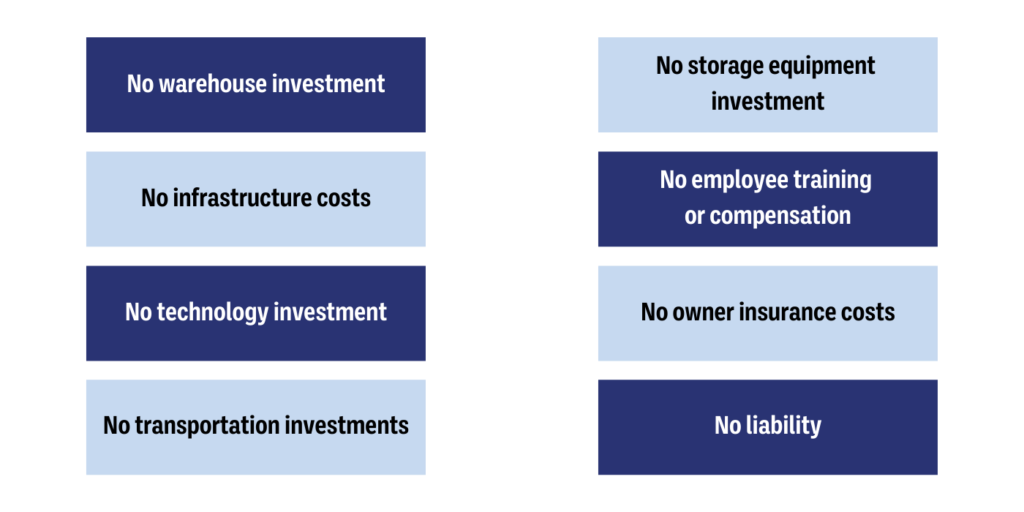
Higher Consumer Satisfaction
Consider start-up in-house fulfillment and the quality that’s crafted into every order. Each customer experience is positive, genuine, and memorable.
Now, consider providing that personal touch to each and every order on a mass scale. This becomes exponentially harder to execute once orders come in at a rate that overwhelms your current capacity.
When scaling your eCommerce with a 3PL partner, you don’t have to choose between quality and efficiency. Your 3PL partner will understand that both go hand in hand and will strive to deliver an unforgettable experience to your customers each and every time.
Integrated Technology
One of the biggest benefits of working with a 3PL provider is the direct access to advanced and integrated technology without investment. Your business can leverage the latest in inventory management software, accurate order processing platforms, and in-depth reporting dashboards.
These costly platforms provide 3PL eCommerce partners with a detailed birds-eye view of the entire fulfillment operation without having to purchase them in-house.
Greater transparency gives you the confidence of better control.
Did you know that Falcon Fulfillment's transparent and proprietary IMS software allows clients to access detailed information in real-time?
Return Management and Customer Service
A massive time-suck for in-house fulfillment is return management and customer service. After creating a memorable product and genuine customer experience, you are inevitably met with returned products and complaints for a variety of reasons.
With a 3PL partner, return management and customer service is no longer the unmanageable task it once was. Instead, it’s a streamlined process that meets the expectations of customers and resolves any concerns your shoppers might have.
This leaves you with more time and emotional brainpower to focus on the rest of your business.
On-Demand Fluctuations
Another benefit of scaling your business with a 3PL partner is on-demand changes can be made on the fly. Regardless of the season, your 3PL partner can scale fulfillment capabilities as needed and keep your eCommerce continuously meeting customer and eCommerce expectations around the clock.
Dedicated Fulfillment Professionals
Sometimes, learning from the master is the best way to go. That’s why, when scaling your eCommerce with a 3PL provider, you will encounter and work with dedicated fulfillment professionals that know the fulfillment industry inside and out. You don’t want amateurs handling one of the most crucial and sensitive procedures of being an eCommerce business owner and operator.
Whether you’re considering going big or you’ve been trying for a while, scaling your eCommerce with a 3PL partner can benefit your business in a variety of ways. From a stronger customer reach and advanced fulfillment technology to flexibility and on-demand fluctuations, a third-party logistics provider is the secret to a successful eCommerce when scaling past dropshipping or in-house fulfillment.
6 Ways to Build a Stronger eCommerce Support Network (with examples)
Becoming successful is tough. Becoming successful without the support you need is virtually impossible. That’s why establishing a support network for you and your business should be a priority for any eCommerce owner. If you feel like you are doing a lot on your own, we are going to share how to build a stronger eCommerce support network by utilizing different online platforms.
How to Build a Stronger eCommerce Support Network

Social Media
Utilizing social media is a no-brainer nowadays. Not only can different platforms be used for marketing and advertising, but they can also be used for personal and professional networking to increase and richen your eCommerce support network. Consider joining groups, subscribing to pages, and following thought leaders.
While Facebook might not be the typical social network you associate with eCommerce support it is still the largest social network globally. Plus, Facebook groups have made it easier than ever to find like-minded entrepreneurs. Here are a few Facebook eCommerce communities you can join today.
Out of all the current social media platforms, LinkedIn is the leader in professional networking and finding support groups for just about anything. Leverage the power of this by joining groups, following similar eCommerce owners, listening to thought leaders, and engaging with the content throughout the entire platform. Check out some of these LinkedIn communities.
-
- E-Commerce Network
- eMarketing Association Network
- Inbound Marketers
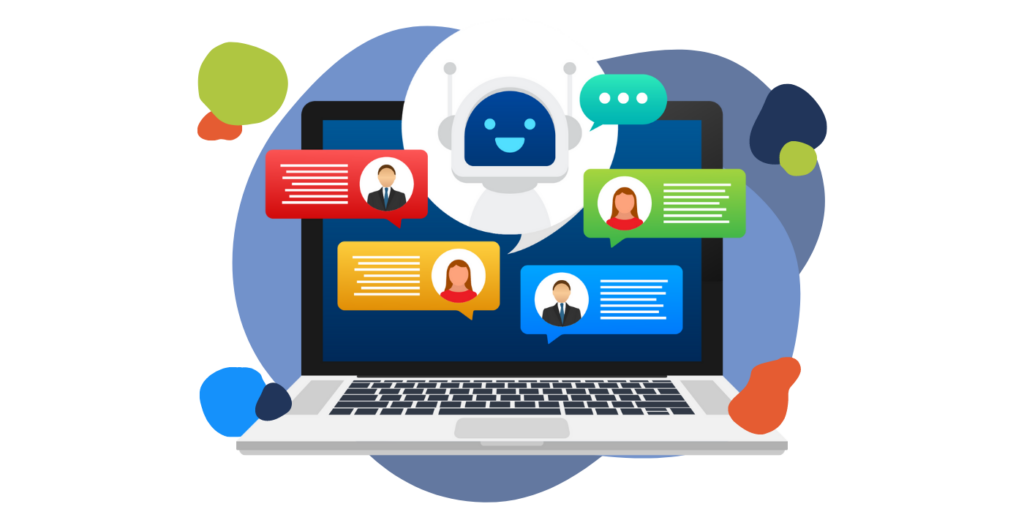
Discord & Slack
Surprisingly, the programs we utilize for work can be simultaneously used for networking and support groups. If real-time conversation and instant messaging forums are appealing to you, joining some of these eCommerce support channels might be beneficial.
| Slack | Discord |
| DTC FAM | DTC Wonderland |

Podcasts
Podcasts are a great way to not only find relevant and valuable insight, but they’re also useful when looking for online communities and finding like-minded people. Take a look at these popular podcasts and see if they’re right for you!

Subscribe to Newsletters
When you subscribe to high-value newsletters, you unlock insider information. Check to see if your favorite bloggers, eCommerce brands, and news outlets have a newsletter to subscribe to. A good newsletter is packed full of valuable information, links to other support groups, opportunities, and other eCommerce outlets. Check out these eCommerce newsletters.

Mastermind Groups
Mastermind groups are a smart way to build a support network for yourself and your eCommerce business. By joining different masterminds specializing in your industry, you unlock powerful peer-to-peer mentorship. People who have been there and done that, can give insight to common problems, challenges, and obstacles you might face. Additionally, you’ll meet fascinating people that will not only influence your business decisions but could also make a personal and beneficial impact. GrowthMentor is a great place to find a mastermind group perfect for you!

eCommerce Summits and Events
Attending eCommerce summits exposes you to similar eCommerce brands looking to network. Summit events are packed with insider information, beneficial relationships, and professional insight from people within your industry. Some well-known events to consider are
Local Support
Don’t forget that support to help you grow and build a successful business could be down the street at city hall. Many local governments, banks, and business networks offer special assistance to local companies.
Having a support network is key to building a successful eCommerce brand. By utilizing social media platforms, subscribing to newsletters, finding new podcasts, and joining groups you didn’t know existed - you can build a great foundation for a support network and drive your business towards success.
Become Stronger with Falcon
Another aspect of growing a successful eCommerce business is knowing when to engage a third-party for support. At Falcon, we pride ourselves on being able to help businesses develop and implement fulfillment processes that alleviate the logistics burden. Our personalized support is one of the many reasons our customers partner with us. With Falcon Fulfillment, you can talk to industry experts, learn from no-fluff eCommerce guides, and successfully streamline your fulfillment process without unnecessary stress.
How to Scale Past Dropshipping
Has your business gone from a sweet side-hustle to a 24/7 churn and you need to outsource some operations to regain a life? We just so happen to know a little bit about a key factor in leveling up your eCommerce business. Today we’re going to share how to scale past dropshipping and what steps you can take right now to expand your eCommerce business.
How to Scale Past Dropshipping
Establish Inventory Space
Whether you’re renting warehouse space, investing in property, or clearing out your garage, having a place to put your inventory is the first obstacle you’ll face when working to scale past dropshipping. Where you choose to put your inventory depends on your budget and the number of products you intend to keep on hand. For many, there are three main options:
Renting Warehouse Space
Renting warehouse space from local businesses allows your eCommerce to scale past dropshipping and take full control over inventory.
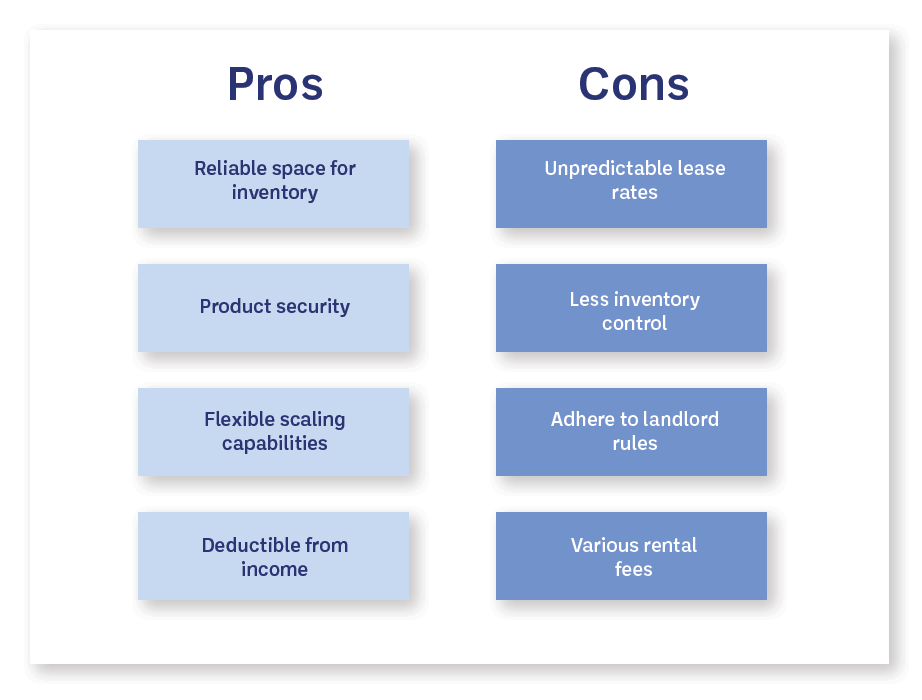
Purchasing Property
Although pricey, if you’re serious about scaling past dropshipping, purchasing your own inventory property might be the most beneficial for mid to larger-sized businesses.
Fulfill Out of Your Home
Sometimes, clearing out the garage and parking the car in the driveway for a little while isn’t the worst idea. For those interested in scaling past dropshipping without high upfront costs or loss of inventory control, this option is for you.
Partner with a Manufacturer
Its common practice to source at least 2 manufacturing suppliers. One oversees and one domestic.
This allows your eCommerce to access lower manufacturing costs while also having a domestic fall-back for any overseas delay. If one manufacturer is good enough for you, consider whether foreign or domestic suppliers would be more beneficial for your eCommerce.
Implement an Inventory Management System
While dropshipping, your inventory was created, fulfilled, and shipped for you. When scaling past dropshipping and transitioning to full inventory control, it’s important to establish an appropriate inventory management system.
Utilizing an IMS for your eCommerce will help inventory be correctly tracked, managed, and stored. This will assist in providing a smooth and hassle-free shopping experience for customers and help create a stress-free environment for yourself and potential employees.
Create Picking, Packing, and Shipping Procedures
Establishing a process for picking, packing, and shipping orders are crucial when providing your own branded experience to shoppers. Whether you’re doing it by yourself or through a fleet of staff, creating a procedure to fulfill orders correctly and in a timely manner is a huge aspect of scaling past dropshipping.
Now, you’re in charge of customer experience. You are the common denominator in receiving orders, packing items, and shipping orders off to create happy customers - how does that responsibility feel?
 CRM Software
CRM Software
Amidst all the other obstacles to face when scaling past dropshipping, customer service is a critical aspect. You’re in charge of customer experience from start to finish with no one else to blame when things go wrong.
This means whether your cellphone is buzzing around the clock or you've outsourced this to a call center, establishing a Customer Relationship Management Software will help you bypass many customer-related hiccups.
Return Management
Ah, return management. The forgotten sector of business ownership that often brings more stress than reward.
Because of this, creating a proper return management procedure (and policy) will potentially save you thousands of dollars and hours along the way.
Fulfill with Falcon
By implementing these suggestions and utilizing warehouse space, manufacturing partners, shipping providers, and fulfillment procedures, you’ll be well on your way to scaling past dropshipping and taking your eCommerce business to new heights.
Make it easy to scale past dropshipping by partnering with Falcon. We can give you all the benefits of personal fulfillment without the investments, risks, and liabilities. Scale your eCommerce now!
8 Valentine's Day Campaign Ideas
Valentine's Day is just around the corner, while we know you already have this year's love campaigns up and running, it's never too early to start thinking about the success of next year. To give you some things to consider, we've come up with 8 Valentine's Day Campaign Ideas that are trending right now. Which ones will you store for the future?
8 Valentine's Day Campaign Ideas
Match Maker Campaign
What’s better than matching with your Honey? An eCommerce store that does the matching for you! Introducing a campaign that matches products together to create ready-to-go personalized bundles is a sure-fire way to retain customers and attract new ones. A few match-making ideas that you can easily start promoting right now could be; matching partner products according to gender, identity, sexual orientation, and even age, creating a themed bundled set, or matching best-selling items with least-selling items. The possibilities are endless!

Self-love Campaign
It’s safe to assume that not everyone is celebrating with others. Creating a self-love campaign for singles and promoting the many ways individuals can treat themselves on Valentine’s Day is a great way to get people on your team. Even if the day of romance isn’t their favorite, show them it can be by shopping with your brand.

Bark to Heart Campaign
Sometimes that special someone has 4 legs, a tail, and a heart full of pure love. Appeal to pet-owners this Valentine’s Day with themed pet products, pet/owner bundles, or even a local fundraiser to make sure owners and pets alike don’t miss out on the love.

Anti-love Campaign
What? There’s people out there who don’t enjoy Valentine’s Day? Big surprise!
Cater to your less-than-loving customers with an Anti-love Campaign. Offer anti-Valentine’s Day themed products, break-up bundles, or even customized items with the name of an ex - for the sole purpose of lighting it on fire. The hateful hilarity for this day could truly be endless. Capitalize on it.

Galentine’s Campaign
Valentine’s Day isn’t just for romance. Remind your shoppers that it’s okay to spoil friends and family with a Galentine’s Campaign. Offer best friend bundled items, girl's night packages, or even supplies for a DIY spa night - the more creative you are, the more fun your customers will have!

Little Me Campaign
Do you know who else loves to be loved? Your kids! Use Valentine’s Day as an excuse to show the little ones some love with a Little Me Campaign for your customers. Think “Easter” but with a giant heart in place of a bunny. Offer love-themed scavenger hunts, hassle-free crafts supplies, mommy and me bundles, daddy-daughter outfits, or even fun bath-time toys for the littlest ones in the family.

Last-Minute Love Campaign
There’s always going to be customers looking for last-minute gifts during the days before every gift-giving holiday. Cater to the procrastinators, the forgetters, and the busy schedulers with a Last-minute Love Campaign. Offer deals on top-rated products, promote expedited shipping, and show just how great a thoughtful gift certificate can be.
At the end of the day, Valentine’s is a time to be grateful and loving toward those most important in your life. That’s why providing a one-of-a-kind experience to customers is such a big deal. By utilizing these campaign ideas you have the ability to retain customers, attract new ones, and establish a presence in the hearts of your shoppers.
Fall in Love with Falcon
Once you’ve chosen which campaigns work best for you, it’s time to focus on executing perfectly to deliver an unforgettable experience to shoppers. Fulfilling with Falcon helps take the stress away from creating themed and personalized experiences while still providing professionalism that sets your eCommerce apart. Fall in love with Falcon this Valentine’s Day and let us help you share that love with customers.
Increase Customer Retention with Falcon's eCommerce Shipping Solutions
A Rise in eCommerce Retail
It’s been 3 years since humanity transitioned their lives to online platforms and the world of eCommerce took off. In 2020, during the peak of the pandemic, people spent $791 billion dollars online.
In 2021, Adobe estimated over $4 trillion dollars in online sales.
2022 is finally here. Brick-and-mortar stores are beginning to re-open and families are spending their weekends at their favorite stop-and-shop locations.
Although in-store shopping is making a comeback, eCommerce sales won’t be going away anytime soon according to these statistics.
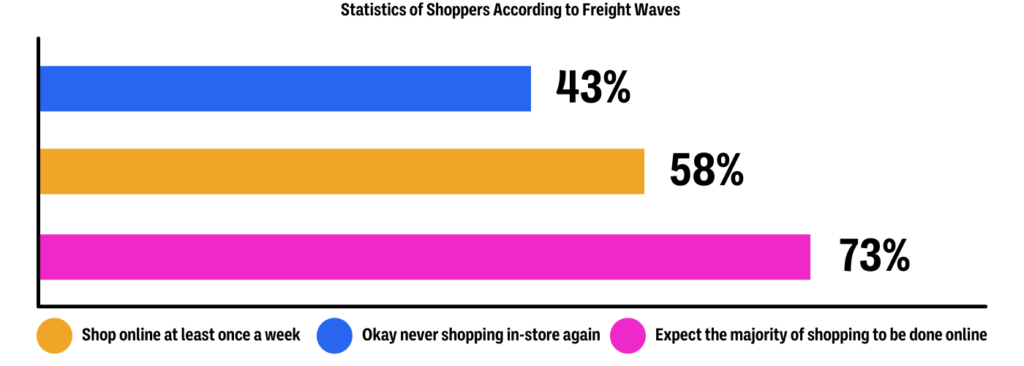
Online shopping is here to stay! It's important to provide the best experience for your customers by meeting their new and growing expectations.
Increase Customer Retention with eCommerce Shipping Solutions
Fast Shipping
After Amazon introduced 2-day shipping, it’s all anyone talked about. Now, 80% of shoppers are choosing same-day shipping and nearly 61% of shoppers want their package within 3 hours or less.
The delivery timeframe is growing shorter and shorter each quarter.
By utilizing faster delivery options, eCommerce brands will entice new buyers and retain existing ones.
Did you know: orders placed before 2PM with Falcon Fulfillment ship out same-day?
Free Shipping
Another important contributor to customer retention is free shipping. Nearly 75% of consumers expect delivery to be free, but how does that impact online purchases?
According to a survey, 77% of shoppers have abandoned their shopping cart because shipping was not free. That’s a lot of potential revenue lost.
Learn 10 ways you can offer free shipping to retain customers, improve customer experience, and create satisfied buyers.
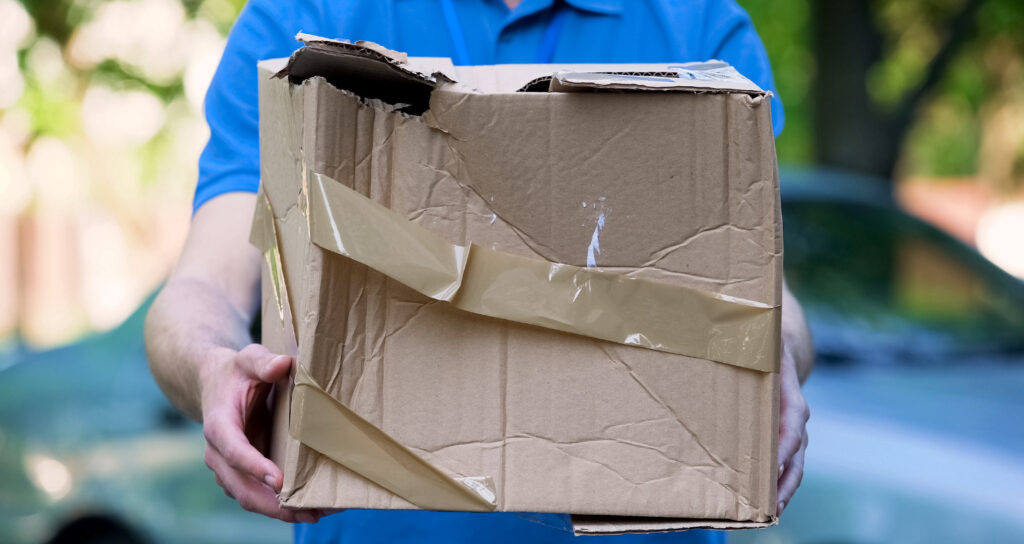
Damage-free Shipping
It’s no secret that some items arrive with damage. Sometimes it happens during transit, during packing, or it arrives that way directly from the manufacturer.
Making sure your company has a proper damage control process will avoid the dreaded moment a customer opens a long-awaited package and - BOOM, broken, tarnished, and almost immediately slapped with a return label.
30% of shoppers receive a damaged product.
Did you know: Falcon staff check items for damages once when being picked and again when being packed?
Eco-friendly Shipping
In 2022, it’s trendy to care about the earth. That’s why 31% of shoppers are willing to pay extra for greener shipping options and 76% would leave preferred brands for a greener competitor.
Equipping your eCommerce with a means of greener delivery or carbon offset programs is a great way to not only give back to the environment but also improve overall customer retention. By appealing to shoppers who might be looking for a greener alternative, you attract new buyers while retaining those wanting greener options.
Did you know: Falcon uses right-size shipping containers and consolidates outbound delivery carriers to reduce vehicle emissions?
Customer Satisfaction
The foundation of an eCommerce business is satisfied customers. Without them, there would be nothing to sell and no profit to make.
That’s why it’s critical to provide your buyers with a fast and hassle-free shipping experience.
-
- 29% of shoppers said they would abandon a brand if their package was delayed just once.
- 55% said they would switch brands when their package was delayed two or more times.
- 69% said they would be less likely to make a repeat purchase if an order was delayed by 2 or more days.
According to Supply Chain Brain
Acquiring a new customer can cost 5 to 25 times more than retaining an existing one.

How Falcon’s eCommerce Shipping Solutions Increase Customer Retention
Reduces Damages and Incorrect Orders
Once a customer places an order through the integrated eCommerce platform, Falcon employees begin picking each item individually to reduce and minimize wrong items, damages, or other mishaps that decrease the overall quality of a buyer’s experience.
Items are then packed and prepared to ship by hand, giving an additional team a second opportunity to check for imperfections and provide your loyal shoppers with a package nothing short of perfect.
Falcon Fulfillment has a 99.996% pick and pack accuracy.
Reducing errors in your pick and pack process will increase customer retention and minimize the need for returns and refunds. Because it often costs more to refund or accept returns, creating a more seamless and hassle-free buying experience will improve your profit margins and likely reduce your company’s overall carbon footprint.
Meets Rising Customer Expectations with 2-Day Shipping
It’s essential as we enter 2022 that your eCommerce provides 2-day shipping to stay competitive. It’s common for consumers to now expect the “Prime Effect” from everyday eCommerce brands.
Falcon Fulfillment has a 96.4% 2-day delivery accuracy.
By utilizing ground shipping and multiple inventory locations, Falcon is able to provide your customers with 2-day and same-day shipping on orders placed before 2PM.
Additionally, Falcon operates 7 days a week order processing. This means that purchases made throughout the week and weekend are being fulfilled in a timely manner. No more waiting through the weekend to see if an order has begun to process. Instead, orders will be waiting on the front lines for carriers to pick up and deliver to their forever home.
Increases Customer Retention with Eco-friendly Shipping
Nearly 45% of consumers are interested in shopping with brands that value sustainability. That’s why Falcon uses right-size shipping containers and consolidates outbound delivery carriers to reduce the carbon emissions given off by delivery vehicles.
Not only does Falcon do its part in reducing vehicle emissions, but it also helps reduce waste on their part, and your customer’s part. By using right-size boxes and bundling orders, Falcon is able to decrease waste and increase the amount of material going to customers that can be recycled or reused.
Falcon can help brands transition to 100% recyclable eCommerce shipping solutions.
Whether you’re ready to step into the fulfillment world or you’re making it work in-house, retaining customers is a high priority. By meeting the various shipping standards of customers and creating a high-quality delivery experience, your eCommerce brand can increase customer retention and attract new shoppers.
Additionally, partnering with Falcon and utilizing their eCommerce shipping solutions is a great option when in-house fulfillment becomes old.
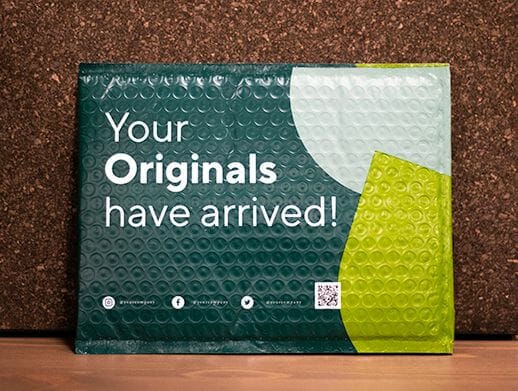
Fulfill with Falcon
When you partner with Falcon Fulfillment, we help you increase customer retention and satisfaction. We help set your brand apart with our attention to detail, personal touch, and hassle-free eCommerce shipping solutions.
Falcon is the eCommerce partner that helps keep customers coming back. We know how important fulfillment is and that’s why we’re experts in it.
Let us take care of it for you.
Selling with Amazon FBA: Is It Right for You?
In this post, we will share some key ideas about Amazon FBA. We will highlight how it works, its pros and cons, and critical decisions that should be considered. Finding the right eCommerce fulfillment partner can be the difference between scaled success or settling for scraps.
If you’ve heard of Amazon, you’ve probably heard of Amazon’s FBA program. If you haven’t - no worries.
What is Amazon FBA?
Fulfilled By Amazon: A fulfillment service offered by Amazon to third-party eCommerce sellers as a way to fulfill and ship orders to customers.
How Does Amazon FBA Work?
Amazon’s FBA program works very similarly to normal fulfillment processes and the services you’d find when working with a third-party logistics provider (3PL). However, when partnering with the world’s leading eCommerce giant, there are definitely a few catches.
First, let’s take a look at the steps involved when selling with Amazon FBA.
-
- Step one: Send your products to an Amazon FBA warehouse
- Step two: Amazon adds your inventory to their warehouse.
- Step three: Customers purchase your products directly from Amazon
- Step four: Amazon picks, packs, and ships out the order
- Step five: Amazon handles customer questions and concerns.
If a product is competing head-to-head with Amazon, it’s not likely the seller’s product will supersede it.
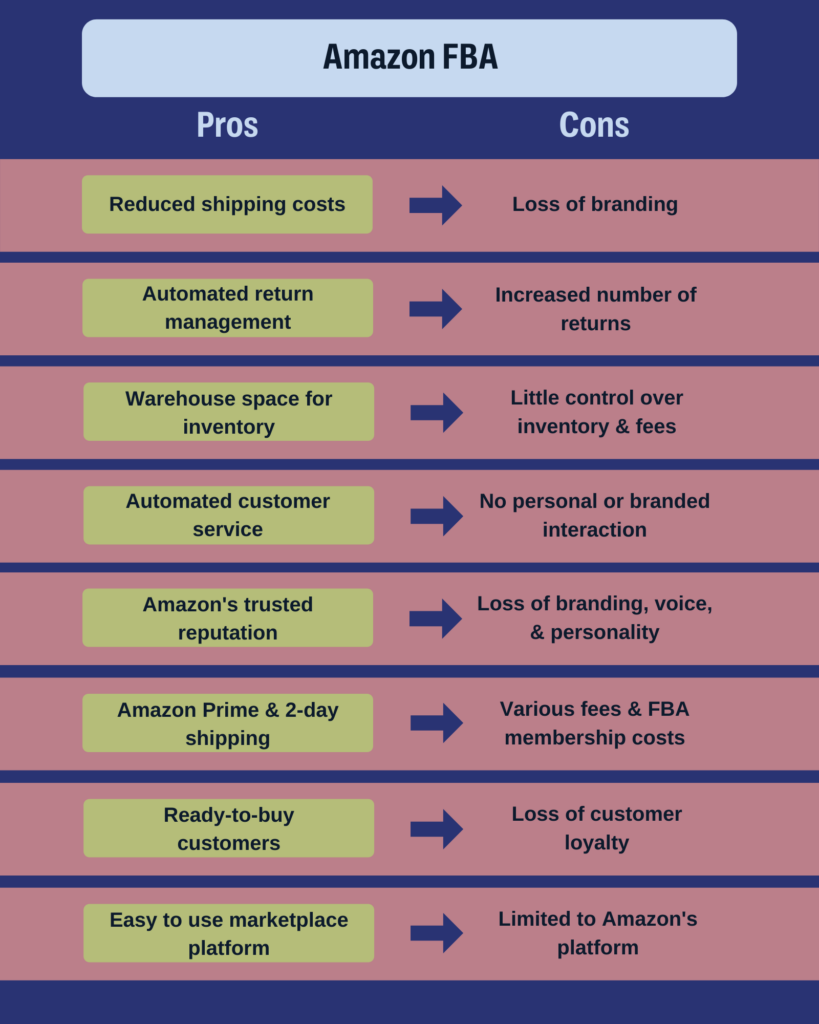
Pros of Selling with Amazon FBA
Reduced Shipping Costs
Because you’re partnering with a fulfillment giant who owns their own fleet of delivery trucks, planes, and even drones - it only makes sense that Amazon would want you to transition to their carriers over domestic options. Even though it comes across as cheaper for you, Amazon is still making a profit on shipping costs.
By utilizing Amazon’s branded shipping carriers through their FBA program, you can find reduced shipping costs for your own eCommerce business in comparison to in-house fulfillment shipping costs.
Return Management
When utilizing their customer service option, Amazon lets you transfer the stress of return management to their shoulders.
Customer service teams will communicate with buyers and provide a hassle-free return experience with little to no help from sellers.
Warehouse Space
Transferring your fulfillment process to Amazon provides eCommerce businesses access to virtually endless storage space - with a price of course. Because Amazon owns and operates multiple distribution centers around the world, benefiting from a surplus of inventory space and speedy delivery times may seal the deal for you when considering Amazon FBA.
Customer Service
Another huge aspect of Amazon’s FBA program is utilizing its customer service platform. Most businesses spend 11% of their annual revenue on their customer service sector. By partnering with Amazon, some eCommerce can reduce the need for customer service platforms, equipment, and in-house agents.
Reputation
As a start-up, it’s difficult to establish a solid reputation. That’s why many eCommerce businesses are partnering with Amazon to leverage and align with their reputation for speed, quality, and convenience.
By associating Amazon’s reputation with your own products, customers are more likely to purchase from little-known sellers when their order is backed by Amazon’s quality guarantee. This streamlines the process for first-time sellers to get products in the hands of shoppers.
Ready-to-Buy Customers
One of the many reasons to start fulfilling with Amazon is the access to millions of ready-to-buy customers. Instead of catching shoppers at the right time with the right promotion and with the right item, your product will be displayed in front of thousands of consumers actively searching to buy that specific item.
Amazon Prime
After Amazon unveiled its Prime membership and 2-day shipping to customers around the world, a new standard was born. The expectation for “Prime” delivery times is now the standard in the eCommerce marketplace.
Getting orders out to customers at such speeds can be difficult for some eCommerce brands. That’s why when you join Amazon’s FBA program, you automatically join the Prime Club and are eligible to offer fast and free 2-day shipping for your buyers.
Cons of Selling with Amazon FBA
The Size of Amazon
With over 9.5 million sellers and 150 million users, it’s no secret that Amazon dominates the online industry.
When considering a partnership with this eCommerce giant, it’s important to note how saturated their seller market is. In 2019, Amazon reported that small and medium-sized businesses sold 4,000 items every minute.
That’s a lot of competition to stand out from.
Amazon Makes the Rules
Amazon has the ability to collect mass amounts of data from its customers, regardless of if they’re purchasing from you or not. With data that is only partially shared with sellers, Amazon has the huge advantage of targeting popular products, winning the Buy Box, and even lowering prices to beat popular bargains.
Common Returns
Although Amazon makes return management easier, they also make it easier for your customers. Partly due to Amazon’s no-questions-asked return policy and generic shipping procedures, your eCommerce will more than likely see a rise in returns after joining Amazon’s FBA program.
Loss of Branding
When you choose to partner with Amazon, you forfeit your right to create a branded shopping experience for your customers. Instead, buyers will see Amazon’s logo on each generic box sent to them.
Additionally, sellers lose the ability to provide personable communication with shoppers and build their buying experience. Instead, shoppers are met with automated Amazon communications and help-desk agents.
40% of consumers said they would consider a repeat-purchase if their order came in gift-like packaging.
Customer Loyalty
As an FBA seller you will have access to millions of shoppers, many of which who are actively looking to buy the products you’re selling. However, even if customers enjoy your product and want to support it, they will ultimately remain loyal to Amazon and its marketplace platform.
Limited Control
One of the biggest cons of partnering with Amazon is how little control you have over your customer’s shopping experience. When selling on Amazon’s platform, Amazon focuses on the product - not the brand.
This will limit you from having any presence on the platform or differentiating yourself from competitors. Customers cannot be redirected to branded websites, see personalized ads, or be given the opportunity to explore other products you might offer.
Saturated Market
It’s no secret that Amazon has millions of active shoppers browsing their marketplace in search of the perfect product. By contrast, Amazon is also home to millions of sellers - including itself.
That’s why when you enter Amazon’s marketplace as a competitor, you are essentially competing against millions of other people, and the biggest eCommerce giant in the world - making it a bit challenging to grow your audience or increase sales profits.
Partnering with Falcon Instead
Even though Amazon dominates roughly 50% of the eCommerce market, it doesn’t mean they are perfect. Where Amazon falls short for its customers, Falcon makes up for it. When choosing Falcon you get a variety of perks you simply won’t find when partnering with big-name companies like Amazon.
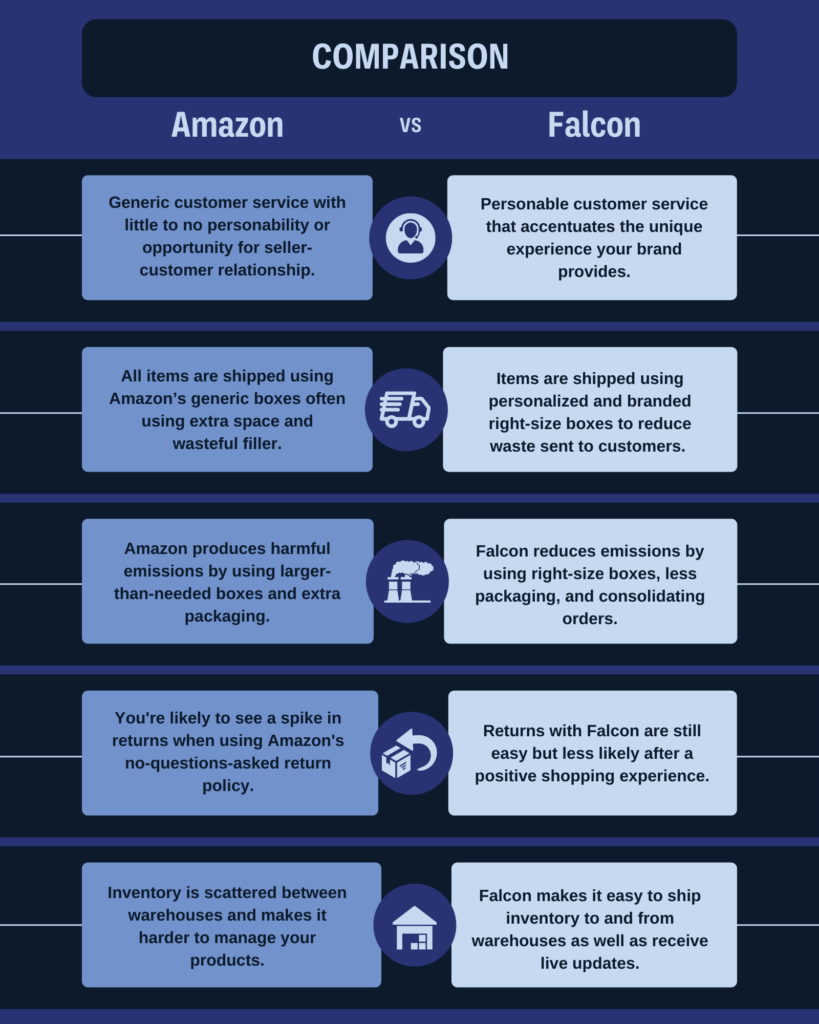
Personable Customer Service
A huge difference between Falcon Fulfillment and working with Amazon is when your customers call in or a client needs attention, you don’t get automation or pinged to the next available agent out of thousands. With Falcon, you’re met with personable service every time.
Whether a customer or partner, communication is valued if not prioritized amongst the Falcon team.
Customer Experience
One of the number one disadvantages of partnering with Amazon is how limited your brand reaches. Regardless of how cool your product is or how custom the packaging is, it’s going to be put into a generic Amazon box for shipping.
With Falcon, you still get the generic box - BUT, it’s customizable to you and your brand. Whether it’s branded tape, logos, inserts, filler - whatever it is, Falcon is sure to create a memorable experience for your shoppers and improve customer experience through and through.
2 and Same-day Shipping
When you choose Falcon, you don’t have to worry about losing the Prime advantage. You’ll still be able to provide 2-day shipping to your customers 7 days a week.
Bonus, if customers place an order before 2PM on weekdays, their order is processed that day.
Less Waste and Emissions
Not only are you still getting the Prime advantage without the ugly logo, but you’re producing less waste and emissions because of it. Falcon works hard to decrease vehicle emissions when possible and limits product waste by reducing needless filler, bundling items, and helping clients transition to greener fulfillment methods.
Return Management
Similar to Amazon, Falcon offers return management that makes it not only hassle-free for your customers, but seamless and stress-free for you. When joining Amazon’s FBA program, you’re likely to see a rise in returns thanks to shipping damages, open-policy returns, and limited customer communication.
With Falcon, since you keep control over your customer experience, you’re likely to see fewer returns and more repeat buyers.
Controlled Inventory Space
Don’t worry about which distribution center your inventory is at and what’s going on with it. When using the inventory space provided by Falcon, your products are on-site and under good care by Falcon personnel.
With full transparency and an automated inventory management system, you’ll know the details of your inventory at any time, anywhere.
Fulfill with Falcon
While selling with Amazon FBA and similar programs might be right for some eCommerce businesses, for others, the benefits are too small in hindsight of the disadvantages we’ve talked about today.
When considering utilizing business services for your eCommerce company, consider Falcon. Because where others fall short, Falcon soars.
The Environmental Impact of Returns: An eCommerce Reality
Over the last couple of years, we've witnessed unprecedented growth in the eCommerce sector. With such transformation, we've also witnessed the environmental impact of returns, which has grown larger than most of us realize.
Today we will be discussing the environmental impact of returns and how your eCommerce business can reduce your carbon footprint by reducing the waste of returned products.
The Rise of Returns
In 2019, the eCommerce sector saw $309 billion in returns. In 2020, $428 billion. With an average return rate of 30% for online purchases and between 8% and 10% for brick and mortar stores, these numbers are only expected to increase as the years continue.
With an influx of eCommerce returns, it’s now customary for more than 60% of shoppers to check return policies before ever considering a purchase. Within the fashion industry, return rates are quickly approaching upwards of 50%.
Why are we seeing these numbers and what do they mean for eCommerce companies, the environment, and your customers?
The Statistics Behind eCommerce Returns
With so many returns happening in almost every sector of eCommerce, it’s difficult to pinpoint where to start making changes and in what ways. If you’re a bit overwhelmed, we’re here to make it a little easier for you.
|
Reason Given |
Verticals with Highest Return |
78% of all returned items were clothing, with 40% of shoppers admitting they bought multiple items with the intent to return all but one.
Statistics tell part of the story but, let’s dive into the environmental impact of returns and what happens to them once they leave the customer.
The Reality of eCommerce Returns
With a quarter of all consumers returning between 5% and 15% of all online purchases, we’re looking at around 5 billion pounds of returned product. Every…single…year.
So, what happens to eCommerce returns? Where do they go?
Well, as great as it would be to assume companies simply re-sell used and unused returned items, that is not the reality. Less than 48% of all returned items are able to be re-sold at full price.
For most companies, the process of re-selling returned items is oftentimes more expensive than simply trashing or burning returned products.
Learn how your eCommerce can start avoiding returns altogether.
Early last year, an Amazon warehouse in the UK was said to destroy 130,000 returned items that were in “good condition” every single week.
For the fashion industry (which is currently ranking highest in returned items), the re-sell rate is much lower. This is because the fashion industry is infamous for its destruction of returned items.
Famous brands like H&M and Burberry have openly admitted to burning millions of dollars worth of returned products each year. Why? Re-selling clothing especially those associated with “luxury brands”, at a cheaper “used” price, would decrease the overall “value” and “reputation” of said brands.
For example, Louis Vuitton burns every returned item in order to remain “scarce”, “desirable”, and “luxurious”. If you could pick up a used Louis Vuitton bag for $40 at Goodwill, suddenly waiting for that deal is more enticing than saving up and purchasing directly from the luxury brand itself.

Given this fact, what happens to the millions of articles of clothing that are returned every year? The answer is simple - it heads straight for landfills.
What happens at landfills? We’ll walk you through it.
Behind the Scenes of a Landfill
Step 1. Once a customer decides to return an item, there are several ways it ends up at a landfill. Sometimes, returned items skip all processes and head straight for a landfill. Other times, items are unnecessarily shipped around the world before ultimately ending up at a landfill.
Step 2. Returned items, along with millions of tons of everyday trash, are tightly packed under a heavy layer of dirt and lined with a layer of rubber and clay. Landfills are not meant to decompose trash, but rather to secure it as more and more is added, buried, and lined every day.
Step 3. Regardless, trash decomposes. Once the layers of trash begin to decompose, a toxic liquid known as leachate begins to form. A lack of oxygen within the layers of decomposing trash causes bacteria to slowly produce methane gas that rises through the artificial barriers - right into our atmosphere.
Step 4. In addition to the enormous amounts of methane being produced and released into our skies, the leachate begins to slowly leak out of the rubber and clay liners. Some of it is reclaimed, treated, and re-used as irrigation, or sometimes drinking water. The unclaimed leachate begins to produce ammonia and mercury, dead-zoning nearby ecosystems.

The Environmental Impact of Returns
Now that you know how landfills operate, let’s consider their overall impact and how much of a difference that one return is really making.
Third Largest Source of Methane Emissions
With agriculture and electricity coming in first and second place for the largest production of human-produced methane, landfills take third place. What quantifies a third-place position? Third-place consists of 5 billion pounds of landfill waste and 15 million metric tons of carbon emissions - every year.
This is the equivalent to the emissions of 3 million cars in one year.
On top of this number, the rate of carbon emissions is expected to increase 30% by 2030.
That’s 3,900,000 cars.
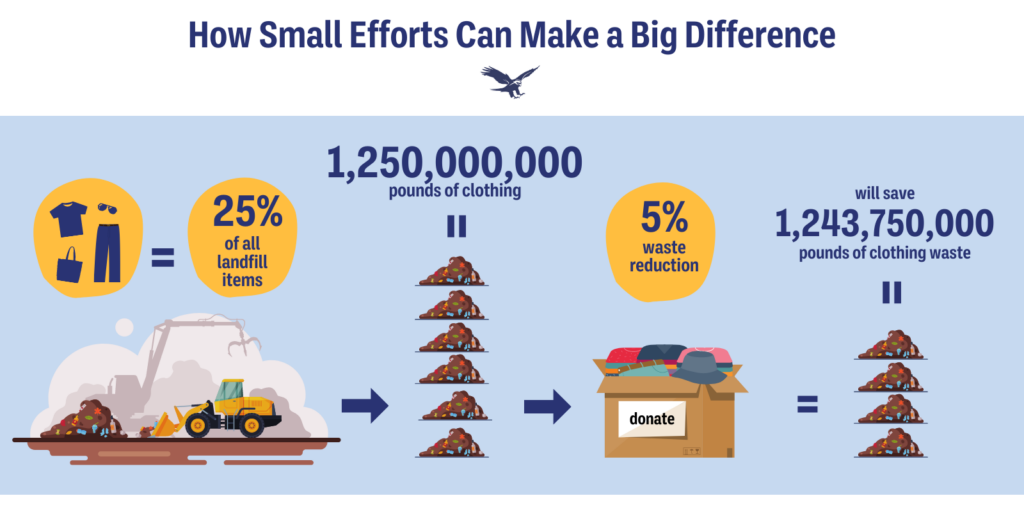
Biodiversity
The average landfill takes up 600 acres. That’s just shy of an entire mile of decomposing garbage.
This contributes to the loss of approximately 20 to 300 species per 100 acres. Animals feed on waste, then transfer toxins to subsequent species that feed on them.
The cycle percolates all the way down to invasive plant species and surrounding soil fertility.
Human Health
According to a study done by the International Journal of Epidemiology, for families living within 3.1 miles of a landfill, there was a strong correlation between Hydrogen Sulphide (a colorless, highly poisonous, flammable, and corrosive gas produced by rapidly decaying organic matter) and deaths caused by lung cancer and respiratory problems - especially in children.
Families living within one mile of a landfill have a 12% increased risk of congenital malformations in their children.
If that isn’t enough, consider drinking leachate (the liquid that leaks out of landfills). Why? Some of us already are.
In 2008, California approved the operation of the Advanced Water Purification Facility. It produces 70 million gallons of drinking water from sewage, every day.
This purified wastewater then supplies about 10% of the water demand for California’s 2.3 million residents.
Economic Effects
Because of the rising trend for purchasing multiple items with the intent to return all but one, companies are now over-producing for misleading demand. This contributes to a 10% loss of global sales and $11.4 billion dollars of possible revenue that’s buried in the dirt every single year.
How to Reduce the Environmental Impact of Returns
Our goal is to help eCommerce companies reduce their overall carbon footprint and motivate shoppers to do the same. Below are a few ways your eCommerce brand can minimize the environmental impact and also that of your customers.
Return Policy
Updating and clarifying your return policy is key when it comes to reducing overall returns. By making return policies prominent, easily accessible, and simple, customers have a higher chance of understanding what they can and cannot do when it comes to returns.
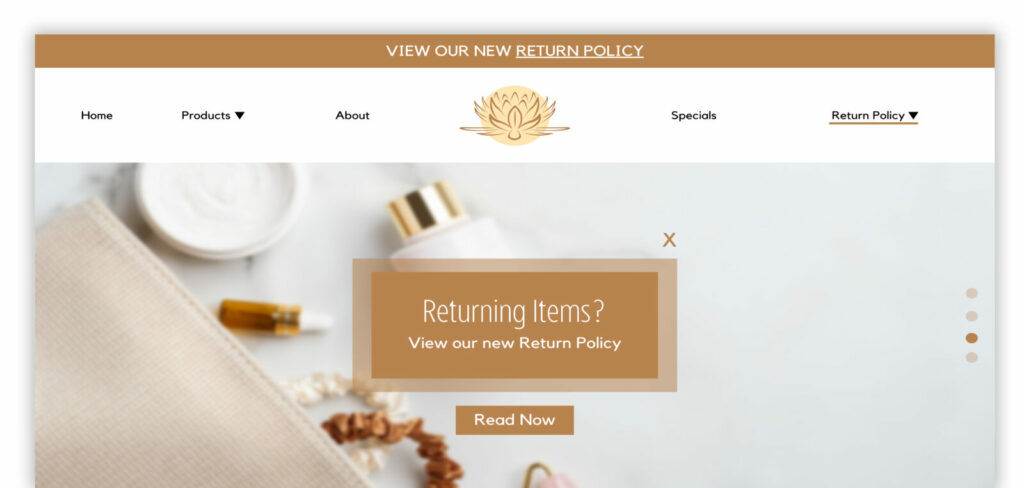
Learn how to create a clear return policy.
Eco-friendly Packaging
Sustainable packaging is big and it’s only going to get bigger. Over half of your customer base is now considering sustainable packaging when choosing a product and whether or not they will shop with a brand.
Greener packaging is a growing favorite amongst consumers, and it’s a simple way to reduce your company’s carbon footprint. Additionally, you can help your customers personally reduce their own carbon footprint by providing reusable packaging or appropriate steps to discard their orders.
If you’d like to learn more about sustainable packaging and how to make the transition for your eCommerce company, check out our guide on sustainable packaging.
Ditch Return Labels
Switch to a return portal instead of providing pre-printed return labels. This not only reduces paper waste but also simplifies customer experience while simultaneously reducing returns.
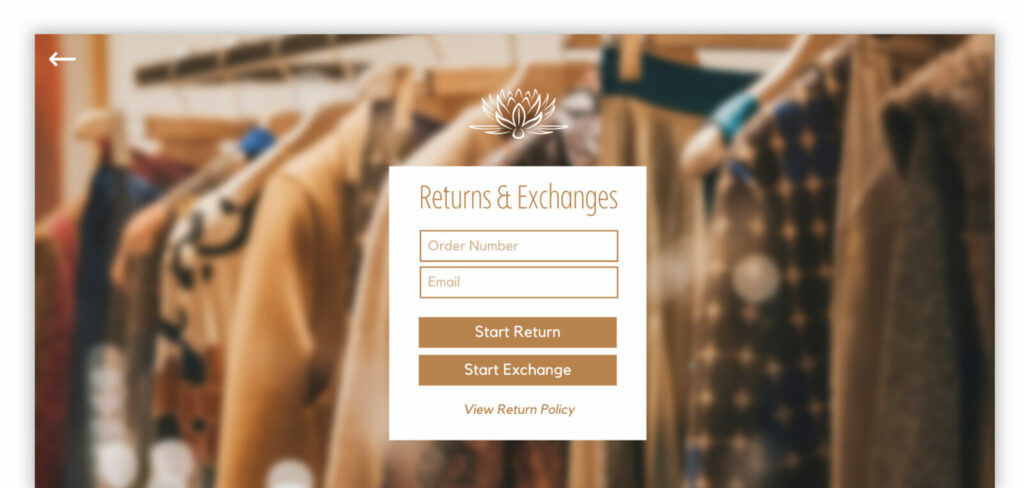
Once customers decide they want to return an item, using a return portal will help determine if an item is suitable for return and also promotes a longer consideration period for a customer before blindly sending an item back.
Exchange over Refund
If customers are able to purchase multiple items and send them all back for a full refund - what’s the point of selling those items in the first place? Make full or partial refunds harder to come by with stricter return regulations and an emphasis on exchanging.
Limiting full and partial refunds will deter customers from buying items with the sole intent of returning them, and will promote a more thoughtful and considerate shopping experience for customers.
Additionally, clearly communicating why your company is moving away from returns and refunds may help bring the attention of shoppers to the direct impact their shopping habits are having on the current return crisis.
Upcycle and Recycle
Ensuring that returned products are not being destroyed or disposed of is the main goal here.
Consider repurposing returned items that do not qualify for re-sell or donation. For returned items that can’t be re-sold at full price but are still in good condition, consider partnering with a recycling program or donation center to ensure products are being repurposed or indefinitely re-sold and used.
A great example of this is Sheets and Giggle’s sheet donation program. For anyone who donates their used sheets to S&G will receive a 10% off code for their new set of sustainable sheets.
Donated items are then repurposed and skip landfills altogether. Creating a landfill alternative is a way to stand out to customers as an environmentally conscious company.
Re-sell Used Items & Donation
Instead of shipping returned items off to the landfill, incinerator, or selling them to companies to only re-sell them again, just double down and start reselling your own returned, used items.
Patagonia is a great example of utilizing the thrift world. Whenever a used item is returned in good condition, it’s re-sold on their own “used store”.
This allows customers to stay loyal to your brand, reduces the number of items going to landfills, and caters to customers who may not want to pay for brand-new products. Not to mention, your company will be profiting on what would otherwise be considered total losses.
In addition to re-selling used items, donating returned products that cannot be re-sold for a profit will continue to reduce product waste and allow even unsellable items to be used, enjoyed, and saved from contributing to pollution.

Incentivize Greener Shipping & BOPIS
Today, shoppers want their orders and they want them now. However, expedited shipping options play a major role in a negative environmental impact.
Encouraging customers with promotions, codes, and freebies to wait that extra day, pick up items from a physical store, or bundle with more products to save future driving trips, will not only help reduce our overall carbon footprint but will also help customers feel rewarded for participating in cleaner acts.
Anti Fraud Tags
It’s more than normal to buy a dress for a certain occasion and then return it the next day. Unfortunately, this is a bad habit that is only growing in popularity.
Investing in security or anti-fraud tags, such as the 360 ID Tag, will help your business send products to customers without shoppers returning them once they’ve been used. Security tags allow customers to try items on and even wear them around town (although the prominent security tag won’t be very attractive).
However, returnability is strongly affected once the tag is broken or tarnished. This will deter customers from making a purchase without the intent of keeping the item - both online and in-store.
Avoid Returns Altogether
The best way to create green returns for your business is to avoid returns altogether. We understand this is easier said than done, but with a big enough effort and a desire to become better, returns can be exceptionally reduced while still providing customers with a satisfying shopping experience.
To learn more about avoiding returns, check out our blog article where we go over exactly that.
Reduce the Environmental Impact of Returns with Falcon Fulfillment
Fulfillment is challenging enough without worrying about your impact on the planet. Follow along with Falcon to learn tips and tricks on successful fulfillment, happy customers, and most importantly - reducing environmental impact.
|
How Has Falcon Reduced Their Own Environmental Impact? |
|
If that sounds like too much, don’t worry. When you’re partnered with Falcon Fulfillment, we do the job of satisfying customers, preparing orders, and minimizing your brand’s environmental impact.
Our clients are important to us and so is the planet. Contact us today and see how Falcon can make a difference for your company, your customers, and your planet.







